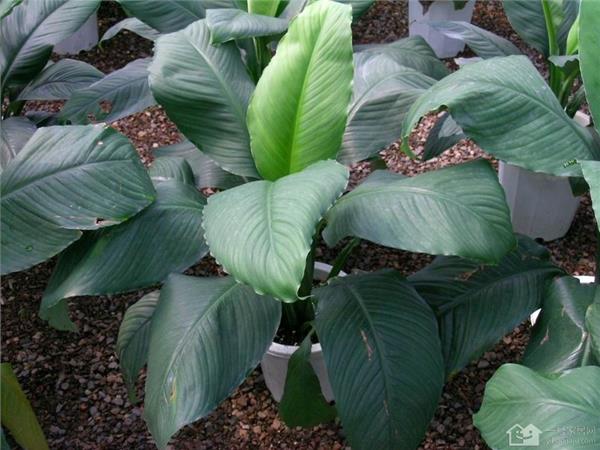What are the characteristics of the Hulk? how to raise the Hulk?
The Hulk, also known as Hulk White Palm and Big Leaf White Palm, is a perennial evergreen shady herbaceous foliage plant of Araceae. Next, let's take a look at how to raise hulks.

The hulk has a developed root system, and the root is brittle and tender, and it is not easy to deep-set. it can absorb water and fertilizer very strongly, especially like big water and fertilizer, so we should choose the culture soil which is loose, fertile, strong in fertilizer and rich in organic matter when potted. A ship can use a mixture of rotten leaf soil, mature sawdust, river sand, perlite and so on as a matrix.
At the same time, a small amount of bone meal, dried livestock and poultry manure and rotten bean cake (as base fertilizer) were planted in the upper basin to facilitate growth. In addition, depending on the growth status, liquid fertilizer or organic nitrogen fertilizer is applied monthly or irregularly, and potassium fertilizers such as plant ash are applied to promote plant growth, make the leaves strong and bright, prevent diseases and insect pests, and maintain the best ornamental condition.
Hulk leaves are magnificent, well-developed roots, great demand for water, and sensitive to water shortage, the leaves wilted at a slight water shortage; such as short-term water shortage, it is easy to recover after irrigation, but serious water shortage will cause dehydrated scorched leaves, and it is not easy to recover. Therefore, during cultivation and maintenance, it is necessary to ensure sufficient soil moisture and maintain high air humidity. In addition to keeping the basin soil moist in high-temperature and dry summer and autumn, it is also necessary to increase the amount of water sprayed on the foliar surface in order to wash away smoke and dust, cool and moisturize.
The hulk is sensitive to light and avoids direct sunlight and can grow normally under scattered light, but too shady for a long time will also cause poor plant growth and reduce ornamental value. The hulk has strong resistance to diseases and pests and is not prone to diseases, but the leaves of the hulk in the vigorous growth period are thick green, which is easy to attract green pests, such as Spodoptera litura. Aphids and Toona sinensis are occasionally seen as harmful young parts of heart leaves when ventilation is poor, resulting in abnormal leaf growth, or missing, or brown spots, affecting ornamental value and normal plant growth. In addition to manual hunting and control, insecticides such as Yitaibao and dimethoate can be used.
The hulk can propagate by ramet and tissue culture. Before the growth point is destroyed, the hulk will not sprout until it is mature; after artificially destroying the growth point, each plant can tiller 3-5 buds, and when the new buds grow to a height of about 15-20 cm, they can be cut and inserted into perlite or coarse sand to let them grow roots.
When cutting, pay attention to take part of the stem and touch the wound with charcoal ash to prevent decay. Families can use this method of ramet reproduction, but the traditional ramet propagation can not meet the needs of the market, and now the seedlings can be propagated rapidly by tissue culture. The tissue culture plantlets can be planted in plastic trays at first, then divided into different plants when they reach 4-5 leaves, and then transplant 3-4 times after changing pots. When the seedlings are about 30 cm high, they can be planted and managed according to conventional cultivation.
The above is the relevant introduction of this article, I believe you have a simple understanding of this after reading it, if necessary, you can continue to pay attention to the No. 1 home network for more information.
- Prev

How to raise ice lantern jade dew the difference between ice lantern jade dew and Ji Yulu
How to raise ice lantern jade dew the difference between ice lantern jade dew and Ji Yulu
- Next

What are the plants suitable for potted plants that are bare at home?
What are the plants suitable for potted plants that are bare at home?
Related
- Wuhan Hospital Iron Tree Blooming Result Was Instantly Frightened by the Gardener Master
- Which variety of camellia is the most fragrant and best? Which one do you like best?
- What is the small blue coat, the breeding methods and matters needing attention of the succulent plant
- Dormancy time and maintenance management of succulent plants during dormancy
- Minas succulent how to raise, Minas succulent plant pictures
- What are the varieties of winter succulent plants
- How to raise succulent plants in twelve rolls? let's take a look at some experience of breeding twelve rolls.
- Attention should be paid to water control for succulent plants during dormant period (winter and summer)
- Watering experience of twelve rolls of succulent plants
- Techniques for fertilizing succulent plants. An article will let you know how to fertilize succulent plants.

